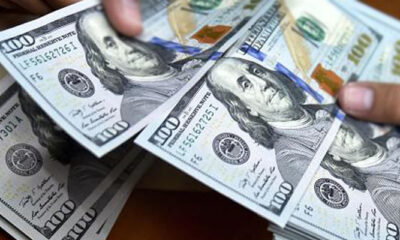Headlines
Naira Slumps To N470 To Dollar, Despite CBN Devaluation of Naira

In Spite of the Central Bank of Nigeria (CBN) devaluation of the naira, the naira is struggling as the exchange rate at the parallel market (black market) dropped to another new 3-year low closing at N470/$1 on Wednesday, July 15, 2020.
Brandnewsday gathers that on the officially recognized NAFEX market, the forex turnover rose by 44.9% while the exchange rate of naira depreciated closing at N386.50/$1.
Parallel Market: At the black market where forex is traded unofficially, the Naira depreciated by N5 to a dollar to close at N470 to a dollar on Wednesday, according to information from Aboki FX a prominent FX tracking website.
This is against the N465 that is exchanged on Tuesday. However, according to sources, during intraday trading, the dollar sold for as high as N470/$ and as low as N465/$1—naira to dollar.
NAFEX: The Naira depreciated against the dollar at the Investors and Exporters (I&E) window on Wednesday, closing at N386.50/$1, compared with the N386 that was reported on Tuesday, July 14. The opening indicative rate was N387.75 to a dollar on Wednesday. This represents a 17 kobo gain when compared to the N387.92 to a dollar that was recorded on Tuesday.
Nigeria maintains multiple exchange rates comprising the CBN official rate, the BDC rates, SMIS, and the NAFEX (I&E window).
Brandnewsday had reported that the CBN responded to the mounting pressure from external lenders, the U.S dollar shortages and a slump in oil prices has flipped the country’s budget. Therefore, leading to the devaluation of the currency.
According to Reuters, traders said the central bank requested dealers to submit official bids at 380 to the dollar last Friday. Meanwhile, the naira closed at 381 to the dollar on Tuesday, down about 5.5 per cent from the previous official rate of 360.
Nigeria is seeking a world bank loan of up to $3 billion. The country has been under pressure from the International Monetary Fund and the World Bank for currency reforms.
Forex Turnover
Meanwhile, forex turnover at the Investor and Exporters (I&E) window recorded an increase on Wednesday, July 15, 2020, as it rose by 44.9% a day on day. According to the data tracked by Nairametrics, forex turnover rose from $12.91 million on Tuesday, July 14, 2020, to $18.71 million on Wednesday, July 15, 2020.
Although there was an improvement, the low turnover reaffirms the scarcity of dollars and an indication of the liquidity pressure in the foreign exchange market. This also is a far cry from an average of $200 million recorded at major trading days during the last few weeks.
Naira Rate Adjustment
Nairametrics reported last week that the CBN official rate has been adjusted from N360 to a dollar to N381 at its SMIS window where forex is sold to importers and SME’s. A note from Renaissance capital suggests that the naira might be depreciated again at the official window if the parallel market or unofficial rate continues to weaken further. As long as there are restrictions on access to dollars, businesses will continue to patronize the unofficial market to meet up with their demands.
Forex News
On Monday, the Central Bank of Nigeria (CBN) had directed all authorised dealers to immediately discontinue the processing of Forms M for maize/corn importation into the country. This directive is contained in a notice that was addressed to authorised dealers and signed by Dr O.S Nnaji, CBN’s Director in charge of Trade and Exchange Department.
The low forex turnover can be attributed to tightened liquidity caused by low foreign exchange inflow and economic uncertainties amid the coronavirus pandemic. Although the Central Bank of Nigeria has been trying to intervene in the foreign exchange market in order to support the naira, the low foreign exchange earnings due to crash in crude oil prices have been a limiting factor.

















